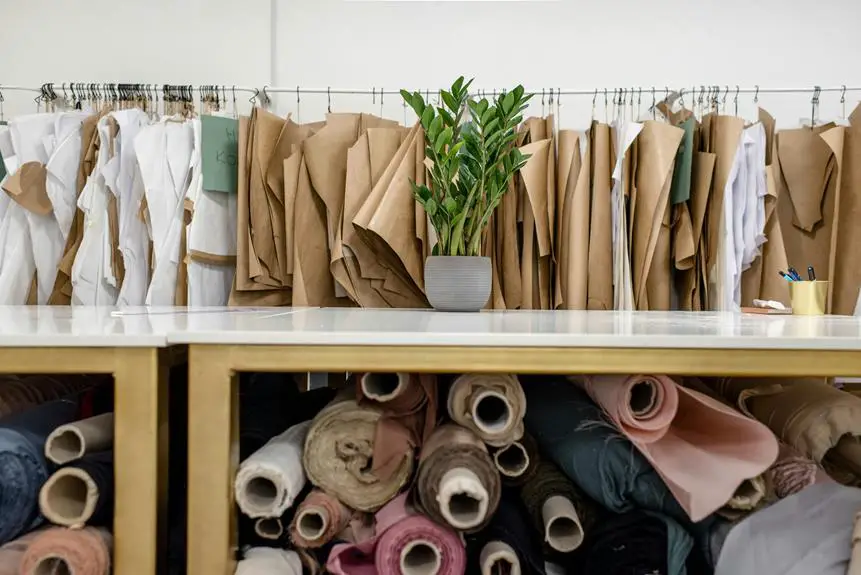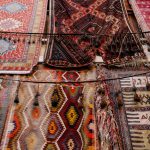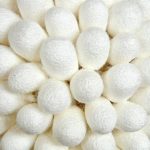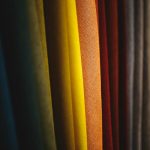When you think of taffeta, you might picture elegant gowns and luxurious events, but its journey starts far away from the runway. From mulberry trees to silkworms, the process of creating this exquisite fabric is both intricate and essential. You'll find that each step, from cultivation to design, plays a crucial role in how taffeta is perceived in the world of fashion today. But what happens when tradition meets modernity in this timeless textile?
Table of Contents
The Origins of Taffeta
Taffeta has roots that trace back to ancient Persia, where it was first woven from silk and prized for its crisp texture and luxurious sheen.
As you explore its history, you'll find that this fabric has been cherished across cultures and centuries. Originally, artisans crafted taffeta by hand, using skilled techniques to create a fabric that's both durable and elegant.
Throughout the Middle Ages, taffeta spread to Europe, becoming a favorite among the wealthy elite. Its ability to hold vibrant dyes made it a popular choice for sumptuous garments and fashionable accessories.
You might be surprised to learn that taffeta also found a place in formal wear, with its structured nature giving a unique silhouette to dresses and suits alike.
The Life Cycle of Silkworms
Silkworms play a vital role in producing the silk that makes taffeta so luxurious, and understanding their life cycle reveals the intricate process behind this exquisite fabric. The life cycle of the silkworm consists of four main stages, each crucial for silk production.
- Egg: It all starts with the female moth laying hundreds of tiny eggs. These eggs hatch into larvae after about ten days.
- Larva (Caterpillar): Once hatched, the larvae begin to eat mulberry leaves voraciously. This stage lasts around 4-6 weeks, during which they grow significantly and molt several times.
- Pupa (Cocoon): After reaching maturity, the silkworm spins a cocoon around itself. This protective shell is made of silk fibers and takes about 2-3 days to complete.
Throughout these stages, the silkworm transforms from a tiny egg to a moth, showcasing nature's remarkable process. By understanding this life cycle, you can appreciate the effort that goes into producing the silk used in taffeta, making it not just a fabric, but a product of a fascinating journey.
Cultivating Mulberry Trees
Cultivating mulberry trees is essential for ensuring a steady supply of food for silkworms, which in turn supports the silk industry. To start, choose the right variety of mulberry tree that thrives in your local climate. Look for disease-resistant types that can produce abundant leaves, as these leaves are the primary food source for your silkworms.
Once you've selected your trees, prepare the soil well. Mulberry trees prefer well-drained, fertile soil rich in nutrients. Plant your trees in a sunny location, ensuring they receive at least six hours of sunlight daily. Regular watering is crucial, especially during the initial growth phase. Keep an eye on moisture levels and avoid waterlogging.
As your trees grow, prune them to promote healthy branching and maximize leaf production. Regularly check for pests and diseases, taking immediate action if you notice any issues. By maintaining a healthy mulberry grove, you'll ensure a continuous supply of leaves for your silkworms.
In this way, you'll not only contribute to a sustainable silk industry but also enjoy the beauty and shade of your flourishing mulberry trees. The connection between the trees and the silkworms is vital for thriving silk production.
Harvesting Silk Threads
When you think about silk, it's essential to understand the entire production process that leads to those luxurious threads.
You'll see how sericulture techniques play a crucial role in nurturing silkworms, and you'll learn about the methods used to harvest silk effectively.
Let's explore these fascinating aspects of silk harvesting together.
Silk Production Process
In the silk production process, harvesting silk threads begins once the silkworms have completed their metamorphosis and spun their cocoons. This crucial stage requires careful timing and technique to ensure you get the best quality silk. Here's what you need to know:
Timing: You'll want to harvest the cocoons before the moths emerge. If they break free, they'll damage the silk threads. Typically, this occurs about 10 days after cocoon spinning.
Boiling: Once you've gathered the cocoons, you'll need to boil them in hot water. This step serves two purposes: it kills the pupa inside and softens the sericin, the substance that holds the silk strands together.
Unraveling: After boiling, you can gently unravel the silk threads. This is done by locating the end of the thread and carefully pulling it from the cocoon. The longer the thread, the better the quality of silk you'll end up with.
Sericulture Techniques Overview
Harvesting silk threads involves a series of meticulous techniques that ensure the highest quality silk is obtained from the cocoons.
First, you'll need to monitor the silkworms closely as they complete their lifecycle. Once the silkworms have spun their cocoons, you should wait for the right moment, typically around 2 to 3 days, when the cocoons are well-formed but before the moths emerge.
Next, you'll need to gather the cocoons carefully, avoiding any damage. This is crucial because even small breaks can compromise the silk thread quality. Once collected, you'll typically immerse the cocoons in hot water or steam them. This process kills the pupae inside and softens the sericin, the gum that holds the silk fibers together.
After that, you can begin unraveling the silk threads. Each cocoon can yield up to 1,000 meters of silk, so you'll want to handle them gently to avoid breaking the delicate fibers.
Harvesting Methods Explained
Carefully monitoring the silkworms as they spin their cocoons is crucial for successfully harvesting high-quality silk threads. Once the silkworms complete their transformation, it's time for you to gather the cocoons. You'll need to pay close attention to the timing, as harvesting too early or too late can affect the quality of the silk.
Here's a simple guide to harvesting silk threads:
- Cocoon Selection: Choose the cocoons that have a uniform color and size. This indicates healthy silkworms and better-quality silk.
- Cocoon Boiling: Immerse the selected cocoons in hot water to kill the pupae inside. This process also softens the silk threads, making them easier to unwind.
- Thread Extraction: Carefully unravel the softened threads from each cocoon. It's essential to handle them gently to avoid breakage, as each cocoon can produce up to 1,000 yards of silk thread.
With these steps, you're on your way to transforming raw silk into beautiful taffeta fabric. Remember, patience and precision are key to achieving the finest quality silk!
Weaving Taffeta Fabric
When you think about weaving taffeta fabric, you're really looking at a complex production process.
Different types of taffeta weaves can create unique textures and finishes, adding to the fabric's charm.
Let's explore how these elements come together to make taffeta a favorite in fashion.
Taffeta Production Process
To create taffeta fabric, manufacturers start by weaving together fine threads of silk, nylon, or polyester on a loom. This intricate process requires precision and skill, as the threads must be aligned perfectly to achieve that signature crispness and sheen taffeta is known for.
Here's a quick overview of the weaving process:
- Warp and Weft Preparation: First, manufacturers prepare the warp threads (vertical) and the weft threads (horizontal). The quality and tension of these threads are crucial for a successful weave.
- Weaving on the Loom: Next, the loom is set up to interlace the warp and weft threads. Depending on the design, different techniques may be employed, but the goal is always to create a smooth, even texture.
- Finishing Touches: Once woven, the fabric undergoes finishing processes such as dyeing and coating, enhancing its durability and giving it that glossy finish.
Types of Taffeta Weaves
Taffeta can be woven in various styles, each offering unique textures and visual effects that cater to different fashion needs. Understanding these weaves helps you choose the right taffeta for your projects, whether it's for a dress, lining, or accessories.
Here are a few common types of taffeta weaves:
| Weave Type | Characteristics | Best Uses |
|---|---|---|
| Plain Weave | Smooth, slightly crisp | Evening gowns, blouses |
| Ribbed Taffeta | Textured with raised ribs | Formal wear, upholstery |
| Jacquard Taffeta | Intricate patterns woven in | Special occasion dresses, curtains |
Each type of taffeta has its distinctive appeal. The plain weave offers a classic look, while ribbed taffeta adds dimension. Jacquard taffeta stands out with its elaborate designs, making it perfect for statement pieces.
When selecting taffeta for your next project, consider these weaves and how they align with your vision. The right weave can elevate your creation and make a lasting impression.
The Role of Designers
Designers play a crucial role in transforming taffeta from a simple fabric into stunning, high-fashion pieces. They take this versatile material and infuse it with creativity, turning it into garments that captivate and inspire.
You'll find that their process involves several key steps to ensure taffeta shines in the fashion world:
- Concept Development: Designers start by envisioning a theme or story that resonates with their target audience. This concept guides their choices in color, texture, and silhouette.
- Fabric Manipulation: Once the concept is solidified, they experiment with taffeta's unique qualities. Designers explore draping, layering, and even dyeing techniques to bring their ideas to life, making the fabric's crispness work in their favor.
- Final Execution: After finalizing the designs, they collaborate with skilled artisans and manufacturers to produce the garments. This partnership ensures that the final pieces not only look great but are also well-constructed, ready to grace runways and closets alike.
Taffeta in Modern Fashion
In modern fashion, taffeta's structured elegance is making a comeback, captivating designers and consumers alike with its ability to create dramatic silhouettes. You'll notice taffeta gracing everything from evening gowns to statement skirts, as it adds an enchanting volume that other fabrics can't replicate. Its crisp texture allows for bold shapes, making it an ideal choice for designers who want to make a statement.
When you explore collections, you might find taffeta paired with intricate embellishments like embroidery or sequins, enhancing its allure. This fabric shines in vibrant colors, reflecting light beautifully and evoking a sense of luxury. You can even see it being used in unexpected ways, such as in casual wear or even accessories, proving its versatility.
For those special occasions, taffeta's ability to hold form ensures you'll turn heads. Whether you're attending a wedding or a gala, wearing taffeta not only elevates your look but also connects you to a rich textile history.
Frequently Asked Questions
What Are the Environmental Impacts of Taffeta Production?
When you consider the environmental impacts of taffeta production, you'll find issues like water usage, pesticide application, and energy consumption. These factors contribute to pollution and habitat destruction, affecting ecosystems and communities negatively.
How Does Taffeta Compare to Other Fabrics in Terms of Durability?
When you compare taffeta to other fabrics, you'll find it's less durable. It creases easily and can fray, while materials like polyester or silk offer better resilience and longevity, making them more suitable for lasting garments.
Are There Any Ethical Concerns Related to Silk Farming?
You might find ethical concerns in silk farming, primarily regarding the treatment of silkworms. Many practices involve boiling them alive to harvest silk, raising questions about animal welfare and sustainability in the industry.
What Are the Best Care Practices for Taffeta Garments?
To care for taffeta garments, hand wash them in cold water, avoid wringing, and hang to dry. Store in a cool, dry place, and use a garment bag to protect against dust and light.
Can Taffeta Be Recycled or Repurposed After Use?
Yes, you can recycle or repurpose taffeta. Look for local textile recycling programs or consider transforming it into new items like bags or home decor, giving your old fabric a fresh purpose while reducing waste.
- What Is Camel Wool Fabric? Everything You Need to Know - July 3, 2025
- The Ultimate Guide to Camel Hair Fabric: Properties, Uses, and Care - July 3, 2025
- Choosing the Right Fabric: Is Bull Denim the Same as Canvas? - July 3, 2025







